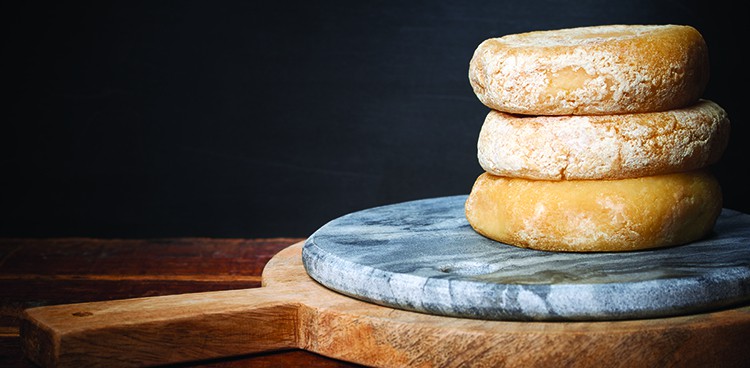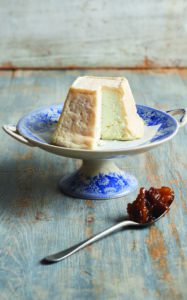
Photographed by: Holly Pickering
We actively encourage all of our cheesemakers to use animal rennet,” says Bronwen Percival, cheese buyer for Neal’s Yard Dairy. “Except for those using cardoon.” It’s a mystical-sounding word, “cardoon,” redolent of Lewis Carroll’s Jabberwocky or a sea monster roiling over medieval maps. In fact, these wild-growing Mediterranean perennials (commonly known as artichoke thistles) do have a fantastical appearance befitting their name: Huge silver-green leaves sprout from fleshy roots, and a fist-size thistle sits atop a rocketing ten-foot stalk. It was a popular crop for Victorian vegetable gardens—the blanched stems offer flavors of artichoke (a relative) and celery—but laborious prep has reduced thistle’s popularity on the plate since. These days, you’re most likely to find cardoon dishes in Italy, North Africa, and France, where the plant grows abundantly.
Concealed within the cardoon’s flower are enzymes, cyprosin and cardosin, that are capable of curdling milk. This makes artichoke thistle a vegetarian alternative to animal rennet (which is extracted from a baby ruminant’s stomach). Cheesemakers who use cardoon report that it differs from animal rennet in that it’s a gentler coagulant, creating a curd that’s more easily broken apart. It imparts vegetal flavors and—sometimes—a slight bitterness to the finished cheese.
Most thistle-rennet cheeses hail from Spain, Portugal, or Italy. This geographical spread could be ascribed to the cardoon’s natural proliferation, but some have suggested—at least on the Iberian Peninsula—that the dispersion matches the flight of persecuted medieval Jews, for whom cheeses made with animal rennet contravened dietary laws.
Regardless of how cardoons got their start in cheesemaking, the method stuck. In Portugal, thistle rennet use can be traced back to the Romans; it’s described as “the curdling herb” in the first-century manuscript De Re Rustica. A 16th century treatise on Spanish agriculture lauds the cardoon in cheesemaking: “For perfection of taste, the best is curdled with the thistle flower, which is sweet and not bitter like that made with animal coagulants.”
Bitter Sweet
That “perfection of taste” is still widely celebrated by the Spanish and Portuguese today—rounds of Torta del Casar or Serra da Estrela often act as party centerpieces, much like fondue in Switzerland. Makers of thistle-rennet wheels are concentrated around Extremadura in western Spain and across the border into Portugal. These cheeses, like those made with animal rennet, are not all alike. Some, such as Torta del Casar, are earthy and intense on the palate, eaten with the top sliced off and the gooey interior scooped out, while others, including Portugal’s Serpa, are firmer and sharp.
Milk, however, matters. The curdling herb traditionally favors sheep’s and goat’s milk; cow’s milk coagulated with cardoons often yields intensely bitter wheels, a result of its different peptide sequences. There are a few exceptions, however, such as the elusive Armada, a Spanish cow’s milk cheese made near Léon.
Curds in these areas are frequently more than just foodstuff. The semi-hard Évora—a raw sheep’s milk cheese traditionally produced using the milk of the indigenous Merino sheep breed—is a classic example. Fresh milk is filtered through a cloth and warmed over low heat before salt and thistle rennet is added. Collected from the countryside, the petals and stamens of the flower are mashed with salt and water and left to ferment for several hours before being added to the cheese. Aged either 30 or 90 days, Évora is piquant and salty in flavor. More than just a tasty morsel, these small, yellow cylinders were historically used as payment for the poorest workers in this once-depressed area; the robust earthenware jars in which they were stored are often used as a decorative element in local homes today, a reminder of that hard history.
Eau de Thistle
Though the cheese earned PDO status in 1996, Évora producers are not immune to the allure of commercial conveniences. According to Victor Lamberto, a self-described “gastronaut” and Slow Food leader of the Alentejo region in southern Portugal, the government has been actively persuading producers to switch from using the traditional stamen-and-petal mixture to a standardized, more reliable industrial version of cardoon rennet.
Établissements Coquard, a French cheesemaking supply company, began selling an industrial cardoon extract five years ago. According to Coquard director, Francis Perret, the product is still little known in the marketplace, but “interesting” as it can shorten the ripening time for soft cheeses. “In general, this coagulant is not recommended for hard or cooked cheeses,” he adds.
This might explain why some cardoon cheeses, traditionally semi-hard in texture, are appearing in supermarkets when younger (and oozier). In Lamberto’s opinion, many Portuguese makers are switching from quality to quantity; cheaper Spanish milk is changing the terroir while new hygiene laws are moving producers off farms and onto industrial estates. Together these elements are eroding the tradition of Évora, and many other thistle-rennet Portuguese wheels face the same fate.
Take heart, however: not all traditional cardoon cheeses are disappearing. Cacio Fiore, a square-shaped ancestor of Pecorino Romano, was almost lost post-WWII when the macro-minded push for economic recovery left no place for farmhouse cheese. Today, following support from the local government and Slow Food, Cacio Fiore is being revived, and its processes enshrined in a Slow Food presidium.
Cardoon in Cold Climes
Though Percival is typically an evangelist for animal rennet, thistle rennet supersedes that. “Using the cardoon flower is a more interesting choice than a laboratory-derived rennet,” she says. “It’s a traditional technique, more interesting from a flavor perspective.”
While researching at Harvard’s Dutton Lab in 2014, Percival sourced cardoon stamen from pioneering English cheesemaker Mary Holbrook, who produces a Portuguese-inspired thistle rennet cheese on her Somerset farm. “They were full of microbes,” Percival says of the stamens. “As with animal rennet, there’s something more complex involved than just the single enzyme that does the work.”
Holbrook can attest to the rennet’s dimension. “The flavor was interesting, different,” she says of her first taste of thistle cheese in 1994. She was so intrigued that she took some cardoons home with her to experiment. The result was the now-famous Cardo, a raw Saanen goat’s milk cheese with a pinkish rind and a complex flavor. “Cardo is exactly the Portuguese recipe,” Holbrook says, “but the end result is totally different as our milk and climate are different. The rind, for example, would be dry and quite leathery in Portugal, whereas here it’s pink and damp.”
Dried cardoon is difficult to acquire in the UK—it tends to rot in cool conditions—and that’s likely the main reason Cardo remains unique in the area. Holbrook has long relied on a closely guarded Portuguese connection for her supply. But with the arrival of the industrial extract, another thistle rennet cheese has debuted on the shelves of Neal’s Yard Dairy.
The French Connection
Sinodun Hill is made by Fraser Norton and Rachel Yarrow from raw goat’s milk sourced from their Anglo-Nubian herd. First created in 2015 and inspired by a French Pouligny recipe, Sinodun Hill is a pyramid shape with naturally occurring blue and grey molds that develop as it ages.
The decision to use cardoon extract was due to a desire, as Yarrow puts it, to make a cheese that was “a pure expression of milk.” Intent on adding as few ingredients as possible, the couple experimented with no rennet (result: too delicate), before trying goat rennet (result: too dense) before exploring various vegetarian rennets.
“We tried microbial vegetarian rennet, but the flavor wasn’t good,” Yarrow recalls. “Then we tried thistle extract. It didn’t click that this was the same plant used in Spanish cheeses, as I’d heard about the bitter flavor it could produce—(if we had known what it was) we would have avoided it.”
Yet cardoon extract offers a slower, more delicate coagulation and helps produce Sinodun Hill’s creamy, almost whipped interior. Yarrow also happily reports an absence of bitterness in this fresh, lactic cheese.
With Sinodun Hill winning the Best New Cheese at the 2017 British Cheese Awards, surely more cheesemakers will investigate the properties of cardoon extract, especially with the true vegetarian label it bestows. It seems there will always be cheesemakers prepared to grasp the thistle—lucky us.
Tasting notes
Cardo
Sleight Farm
Somerset, England
Raw goat’s milk
A washed rind gives way to a glossy paste with a floral flavor and a chalkier, curdier core.
Sinodun Hill
Nettlebed Creamery
South Oxfordshire, England
Raw goat’s milk
Inspired by a Pouligny-Saint-Pierre recipe, Sinodun Hill is bright and lactic with a delicate, fluffy texture and faint notes of almond and citrus.
Serra da Estrela DOP
Casa da Prisca, Trancoso, Portugal
Raw sheep’s milk
Traditionally produced in the Serra da Estrela mountains, it’s typically eaten by slicing off the top and scooping out the sweet, gooey interior. Delicious with quince paste.
Azeitão DOP
Simões, Azeitão, Portugal
Raw sheep’s milk
The soft paste of this brine-washed cheese has a sweet flavor and a spicy finish. Pair with sourdough and pumpkin jam.
Évora DOP
Monte do Ganhão, Sousel, Portugal
Raw sheep’s milk
Sharp citrus and spice are accompanied by a mild bitterness. A notably salty cheese, Évora is magnificent shaved onto a salad.
Serpa DOP
Herdade dos Cotéis, Moura, Portugal
Raw sheep’s milk
Named for the medieval walled town in south Portugal, this semi-soft round is all cream and fruit with a tangy finish.
Torta del Casar DOP
Queso del Casar, Casar de Cáceres, Spain
Raw sheep’s milk
The near-liquid interior is wonderfully earthy. Bake it in the oven, then dunk breadsticks in the warm, hay-scented paste.
Cacio Fiore DOP
Caseificio De Juliis, Rome, Italy
Raw sheep’s milk
Similar to its famous descendant, Pecorino Romano, this semi-soft square (whose name translates to “flower cheese”) has a sharp, strong flavor with a slightly bitter edge.









I work for a company in the United States that produces a commercial Thistle rennet. If you are interested in learning more about Thistle rennet, please visit our website, Thistlerennet.com.